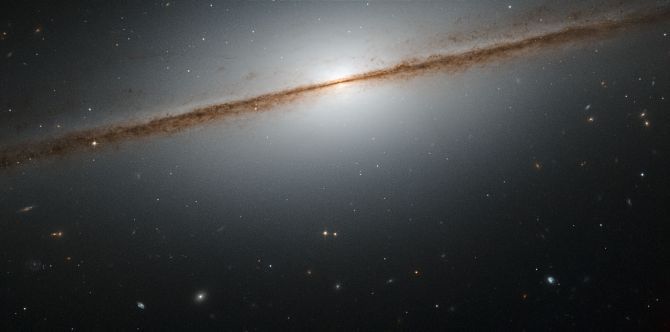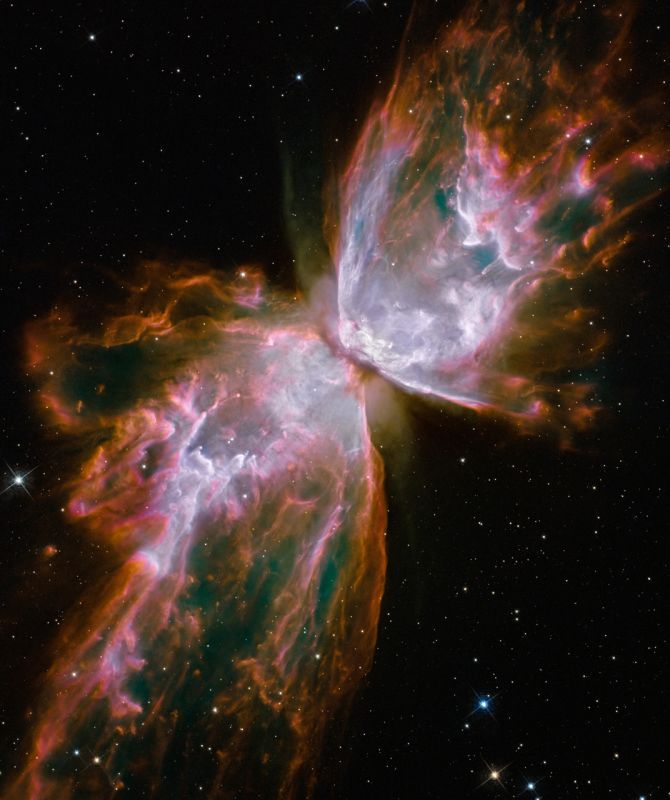In its short life of 25 years it has witnessed a breadth of the cosmos that few humans may ever witness in person. NASA's Hubble telescope has revealed facets of space and time that had for much of human existence lingered in the shadows of imagination of scientists and philosophers. Today, the telescope, named after the astronomer Edwin Hubble, continues to provide views of cosmic wonders never before seen and is at the forefront of many new discoveries.
As the Hubble space telescope gets ready to celebrate 25 years since its launch, Rediff.com look back at some of the iconic images it has produced.
Let's see more gorgeous photos taken by Hubble.

Appearing like a winged fairy-tale creature poised on a pedestal, this object is actually a billowing tower of cold gas and dust rising in the Eagle Nebula. The soaring pillar is 9.5 light-years, or about 57 trillion miles, high, about twice the distance from our Sun to the nearest star. Photograph: NASA/Hubble

The Hubble community bids farewell to the soon-to-be decommissioned Wide Field Planetary Camera 2 (WFPC2) onboard the Hubble Space Telescope. In tribute to Hubble's longest-running optical camera, a planetary nebula has been imaged as WFPC2's final "pretty picture. Photograph: NASA/Hubble

This new NASA/ESA Hubble Space Telescope image shows the galaxy IC 335 in front of a backdrop of distant galaxies. IC 335 is part of a galaxy group containing three other galaxies, and located in the Fornax Galaxy Cluster 60 million light-years away. Photograph: NASA/Hubble

This planetary nebula is 5,000 light-years away, appearing in the large but faint constellation of Camelopardalis, "the Giraffe." Photograph: NASA/Hubble

Nearby spiral galaxy NGC 1433, at about 32 million light-years from Earth, is a type of very active galaxy known as a Seyfert galaxy. Photograph: NASA/Hubble

NASA's Hubble Space Telescope caught Jupiter's moon, Ganymede, seemingly playing a game of peek-a-boo in this image from April 2007. Ganymede is shown just before it ducks behind the giant planet. Ganymede completes an orbit around Jupiter every seven days. Photograph: NASA/Hubble

NGC 7814 is also known as the “Little Sombrero.” It and its apparently-larger namesake, the Sombrero, are stunning edge-on galaxies. Photograph: NASA/Hubble

Your treat? An eerie, close-up view of Jupiter, the biggest planet in our solar system. Photograph: NASA/Hubble

A new image of the sunward plunging comet ISON suggests that the comet is intact despite some predictions that the fragile icy nucleus might disintegrate as the sun warms it. Photograph: NASA/Hubble

The largest NASA Hubble Space Telescope image ever assembled, this sweeping bird’s-eye view of a portion of the Andromeda galaxy (M31) is the sharpest large composite image ever taken of our galactic next-door neighbour. Photograph: NASA/Hubble

This new Hubble photo is but a small portion of one of the largest seen star-birth regions in the galaxy, the Carina Nebula. Towers of cool hydrogen laced with dust rise from the wall of the nebula. Reminiscent of Hubble's classic image of the Eagle Nebula dubbed the 'Pillars of Creation' this image is even more striking in appearance. Photograph: NASA/Hubble

The bright clusters and nebulae of planet Earth's night sky are often named for flowers or insects. Though its wingspan covers over 3 light-years, NGC 6302 is no exception. With an estimated surface temperature of about 250,000 degrees C, the dying central star of this particular planetary nebula has become exceptionally hot. Photograph: NASA/Hubble

Astronomers have long puzzled over why a small, nearby, isolated galaxy is pumping out new stars faster than any galaxy in our local neighbourhood. Now NASA's Hubble Space Telescope has helped astronomers solve the mystery of the loner starburst galaxy, called NGC 1569. Photograph: NASA/Hubble

Astronomers have used NASA's Hubble Space Telescope to photograph the iconic Horsehead Nebula in a new, infrared light to mark the 23rd anniversary of the famous observatory's launch aboard the space shuttle Discovery on April 24, 1990. Photograph: NASA/Hubble





